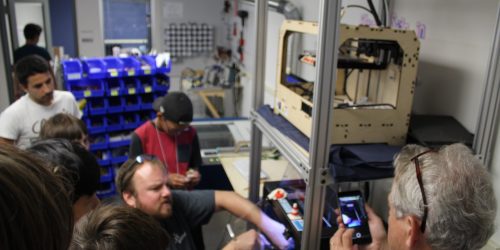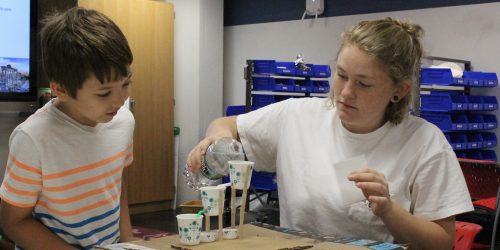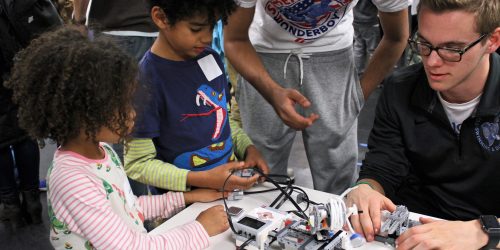By Libby Albanese, Thomas George, Elizabeth Moison, and Leah Sugrue, CEEO STOMPers
Tufts Center for Engineering Education and Outreach (CEEO) had another successful and impactful year with it’s Student Teacher Outreach Mentorship Program (STOMP). We are excited to share with you one of the curriculum’s that STOMP Fellows developed and implemented this past Fall ’18/Spring ’19 semesters. Read below to hear directly from the STOMP Fellows and they Engineering Design Notebooks!
This year, we decided to try something new in our classrooms! We wanted to come up with a way to get students to document their work and be more purposeful about planning during our one hour, weekly STOMP session. We came up with the idea of engineering notebooks, which we would use in the classroom for students to keep all of their ideas in one place. Engineering notebooks were used as places for students to plan, ask questions, document their process through the engineering design process, learn new vocab and even answer reflection questions. Importantly, we also used them to give direct and personal feedback to every student on a weekly basis.
Notebooks were able to accomplish a lot for us in our classrooms. Because we only have an hour with students each week, notebooks helped us extend the time we spent with students outside of the classroom by writing directly back to them and making comments on their designs and questions. It also helped to bridge language and skill differences, giving students the option to draw instead of write, or a space to put translated vocabulary and instructions. We were able to connect directly with every student and help them become better engineers! Notebooks were a way to scaffold the first parts of the engineering design process that normally get ignored, steps like “ask” and “imagine.” By incorporating notebooks into our lesson plans, we were able to scaffold learning engineering professional practices in new ways!
Here are our individual reflections:
Liz: I was thrilled about how our notebooks went this year. Students could use them to communicate in all sorts of ways that we didn’t have before. They could use their notebooks to talk about designs they did in the past, ask us questions, write procedures, and comment on our feedback. Our word of the day one week was “communication,” but I think we could call it the word of the year with notebooks!
Tommy: When Liz and I began charting the course for a curriculum that explicitly emphasized the practices of engineering (“professional skills” such as communication, teamwork, planning, iterative design), we understood the best way to provide an authentic engineering experience was through long-term projects that gave students agency in all stages of the engineering design process, from brainstorming and down-selecting the problems they wanted to address to multiple weeks of self-designed tests and iterative design. In order to allow such creative freedom in our class while remaining supportive educators for our young learners, engineering notebooks were indispensable in tracking week-to-week project progress. In this way, we could show up in our two classes every week and consistently demonstrate just how invested we were in the unique individual work of each of our 50+ students. Better planning leads to better teaching, and notebooks were the tools we required to be effective educators within a structure intended to facilitate authentic engineering experiences.
Leah: The notebooks were an incredible tool, but more so they were so fun for both us and the students! Having only one semester to get to know the kids in our classes, these notebooks really helped expedite the “getting to know you phase”. I was able to have real connections with each student every class whether in person or in writing and that’s what makes these notebooks oh so special!
For us, engineering notebooks were a completely new experiment in the classroom. STOMPers had never done or been asked to do something like this before. These notebooks are meant to be a learning and teaching tool that are in development, and as more and more STOMPers begin to implement them in the classroom, their use will grow and improve. Our goal is that engineering notebooks can be used in new and creative ways. As STOMPers, we normally do not have tools for engaging with student work outside of the hour that we’re in the classroom. By opening up the opportunity to do more work outside of the classroom, we’re hoping that STOMPers can leverage our collective knowledge as educators (and not just engineers) to become better teachers.
If you are interested in hearing more about the notebooks, please reach out.





